The WaterSense Blueprint
The WaterSense Blueprint: Issue VII, Fall 2015
The WaterSense Blueprint is a quarterly update dedicated to news and events related to WaterSense labeled new homes. Sign up to receive The WaterSense Blueprint and get WaterSense news delivered right to your Inbox. You can also help spread the word by distributing Blueprint (5 pg, 1.5MB, About PDF) to builders and developers looking to incorporate water efficiency into their projects. If you missed any of our previous issues, you can find them in our Blueprint Archives.
In This Issue:
- Builder’s Beat: Leveraging Landscapes to Beat Drought
- Did You Know?
- Marketing Corner: When In Drought
- Calendar of Events
In This Issue
While the dog days of summer might be coming to a close, there are many places across the country that are still dealing with the impacts of a hot, dry summer. The U.S. Drought Monitor![]() as of early August shows the entire West Coast and other areas across the country are dealing with drought in some form.
as of early August shows the entire West Coast and other areas across the country are dealing with drought in some form.
WaterSense labeled homes are well-equipped to help mitigate the effects of drought. In this issue, we explore how KB Home works to ensure healthy, water-efficient landscapes for its WaterSense labeled homes. We also offer tips and tools for educating homeowners about drought and how to reduce outdoor water use.
As always, our Calendar of Events lists items of interest for WaterSense partners and stakeholders.
We want Blueprint to cover the topics you’re most interested in, so please don’t hesitate to let us know what future topics you’d like us to address. Email those and other comments to watersense@epa.gov.
Builder’s Beat: Leveraging Landscapes to Beat Drought
WaterSense labeled homes are designed to save homeowners water both inside and out, but it’s really the features included outdoors that can be a savior in times of drought. Landscapes of WaterSense labeled homes follow some important rules to help homeowners avoid water-related headaches: use the right plant in the right place; water only when needed by installing a WaterSense labeled irrigation controller; and work with a professional who knows water efficiency.
For more about how to be proactive against dry spells, WaterSense went to two experts: KB Home Vice President of Sustainability Jacob Atalla and Weiland & Associates, Inc. Vice President of Design and a licensed Landscape Architect Kim Lonigro. As a major home builder in California, KB Home is no stranger to the challenges of drought, and landscape design firm Weiland & Associates, Inc. has helped KB Home make sure its landscapes curb water use without losing their curb appeal.
Q: Why is it important for a builder to consider drought when planning construction for a new home? Have your customers shared concerns about drought with you?
Atalla: Water is a truly limited resource with no substitute or guarantee of replenishment. Homebuilders are in a unique position to influence the water consumption habits of thousands of new home buyers each year. By helping our new homeowners reduce their water use, we support conservation of this precious natural resource. Using less water also contributes to lower energy and water bills, ultimately lowering the cost of homeownership.
When our customers begin the home purchasing process, our trained professionals take the time to explain their homes’ water-efficient features and how KB Home has considered every part of the home to maximize its water efficiency. Especially with the current conditions in California, buyers appreciate the peace of mind knowing their new home’s built-in features are water-wise and can result in lower utility bills.
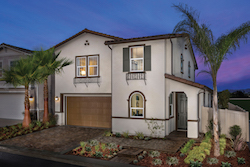
The finished product: a water-efficient and beautiful
landscape at a WaterSense labeled home.(KB Home Cadenera Community in West Covina, California)
Q: How has the drought in California affected KB Home? What are the challenges and opportunities?
Atalla: As one of the largest homebuilders in California, we are leveraging our scale to make an impact in a state facing an unprecedented water shortage. While our commitment to conserving water precedes the state’s current drought, we are particularly proud of the strides we have made in the Golden State. We expanded our number of WaterSense labeled homes and increased our standard water-smart features and options. All KB Home communities in California feature California-Friendly® plants, drought-tolerant landscaping, weather-based irrigation controllers, and highly-efficient irrigation sprinkler heads.
Our early adoption of water-efficient landscaping in 2010 has helped us ready ourselves for California’s drought conditions and even for the governor’s recent emergency regulations. KB Home takes a community-wide approach to water conservation, using drought-tolerant landscaping in common areas and crafting homes and landscapes with water conservation in mind from the start. By design, this community-wide approach reduces the potential challenges faced by individual homeowners interested in switching to water-smart outdoor landscaping. We are able to make drought-tolerant landscapes more cost-efficient through our scale, versus a one-off conversion of an existing home. With the challenge of combating water scarcity amid growing populations, we are optimistic about the opportunity to build entire communities that are designed to conserve this precious resource.
Q: From a landscape architect’s perspective, what are the biggest homeowner benefits of a landscape that meets the WaterSense new home specification?
Lonigro: Poorly designed, water-wasting landscapes can use as much as 3,000 gallons a day, especially when they include turfgrass, flowers, and plants that don't work well in that particular climate or region. We avoid that with KB Home’s WaterSense labeled homes by carefully considering drought tolerance and water efficiency as an integral part of the landscape design process. The result is a beautiful, drought-tolerant, and water-efficient landscape that saves money from day one.
Atalla: Low-maintenance too!
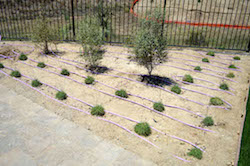
Dripline irrigation in a shrub planter bed. Water is delivered at the soil line to eliminate overspray and water runoff. Purple driplines denote the use of greywater for the irrigation system. (KB Home Sea Cliff Community in San Diego, California)
Q: What is your process for ensuring that a landscape will meet the criteria of the WaterSense specification and maintain curb appeal? How do you approach different types of regions and lots?
Lonigro: Our design approach begins with careful consideration of climate and region for each of the new communities we work on. Our projects throughout the state of California can have climates that span from freezing temperatures to extreme desert highs. The landscape design needs to incorporate features that are regionally appropriate.
Plant selection is especially critical to regionally appropriate design. What is aesthetically pleasing and drought-tolerant in desert communities is not necessarily appropriate or pleasing in an inland valley or coastal community. There is an ever-increasing palette of natives, as well as drought-tolerant ornamental plants, available in the nursery industry today that give designers a wide variety to choose from without repeating the same design over and over again. An appropriate application of mulch also helps the soil retain moisture applied through the irrigation system so that more water can be absorbed by the plants before it is lost to evaporation.
Our irrigation system design is adjusted to the region and corresponding landscape design. WaterSense labeled irrigation controllers provide “smart” self-adjusting irrigation schedules based on the local climate and automatically shut off in the event of rain. Water distribution is carefully controlled through proper system zoning and the use of appropriate watering equipment, such as dripline for denser plantings in coastal and inland valley communities and individual emitters for sparser plantings in desert and high-elevation communities. Trees are also watered separately from shrub areas to provide additional water needed for deep watering.
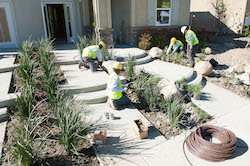
With the planting in place, landscape contractors begin to install dripline irrigation that will water plants at their rootball, eliminating overspray. (KB Home Rancho Santalina Community in San Marcos, California)
Q: Do you have advice to share with builders outside of California and other drought-prone regions?
Lonigro: Make a conscious decision in your everyday community planning and budgeting to participate in programs like WaterSense and be proactive to changing regulations, especially with regard to green building and water-efficient practices.
Plan ahead on how you want to achieve your water savings in the landscape and work with your designers and contractors on anticipating any cost impacts to your current design and construction methods.
Atalla: Builders should be proactive in their water strategy. KB Home has long prioritized water conservation in its development projects, and these years of careful planning and strategic approach to water conservation have spurred us to build increasingly water-efficient new homes.
Lonigro: Your landscape professionals should also be working closely with the nursery industry to take note of availability and stock. Although there are many beautiful plants to choose from, they might not all be available in the quantity or quality needed or be appropriate for production building. Questions to consider are what’s available, what isn’t available, and whether plants might be suffering from a specific issue that should be taken into consideration. Having to make last-minute field substitutions or replace plants due to customer service issues can add time to your schedule and cost to your project.
Communicate with your design teams and keep current with irrigation technology and what has been certified and what has not. Find out what products are changing and determine if there are cost impacts that should be considered in future projects.
Last but not least, stay in touch with local water agencies and be aware of any pending changes that are coming so you aren’t surprised by them and have input during this process. These changes can have significant impacts to your project budgets.
Did You Know?
With WaterSense labeled homes, a healthy yard isn’t hard!
WaterSense labeled homes feature WaterSense labeled irrigation controllers if an irrigation system is installed. These controllers act like a thermostat for a home’s sprinkler system, telling it when to turn on and off. Local weather data and landscape conditions are monitored to tailor watering schedules to actual onsite conditions, ensuring watering schedules better match plants’ water needs. Replacing a standard clock timer with a WaterSense labeled irrigation controller can save an average home nearly 8,800 gallons of water annually.
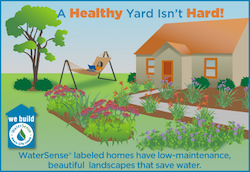
Use this infographic on websites and via social media to illustrate for your customers that water-smart yards can be both low-maintenance and aesthetically pleasing. You can download the infographic from the WaterSense partners’ website.
WaterSense labeled homes’ with irrigation systems have also been designed or installed and audited by a certified professional—specifically an irrigation professional that has completed a WaterSense labeled certification program. With proper installation, programming, and maintenance, homeowners can use their systems without worrying about wasted water and save money at the same time.
Find out how WaterSense is addressing outdoor water use beyond WaterSense labeled homes.
Marketing Corner: When in Drought
WaterSense labeled homes have yards that are water-efficient and low-maintenance , all while maintaining their beauty. With persistent drought affecting many areas of the country![]() , now is a great time to encourage homeowners to reconsider how much water lawns and other thirsty plants use and instead root for plants that require less water. Consider the following tips and tools to help your customers start saving water outdoors:
, now is a great time to encourage homeowners to reconsider how much water lawns and other thirsty plants use and instead root for plants that require less water. Consider the following tips and tools to help your customers start saving water outdoors:
- Tip: Take a sprinkler break. Grass doesn’t have to be bright green year-round. It’s natural for landscapes to go dormant and look a little less vibrant during drought. Also, raise your mower blade and leave the grass a little long to help grow a more drought-resistant lawn with deeper roots, reduced evaporation, and fewer weeds.
- Tool: “When in Drought” Animated Video. Share this animated video on your website and social media channels to remind homeowners and facility managers to save water during times of drought. Any video editing software (e.g., Adobe Premiere, Final Cut Pro, Corel Video Studio, etc.) can be used to add your company’s logo at the end. Note that anyone can view the video on YouTube
 , but you can only download it from the WaterSense partner site.
, but you can only download it from the WaterSense partner site. 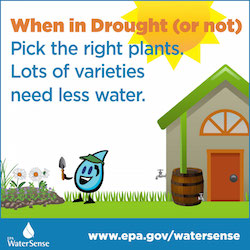 Tip: Use regionally appropriate, low water-using, and native plants. One of the requirements for a home to earn the WaterSense label is to install a water-efficient landscape. Using the right plant in the right place and the WaterSense Water Budget Tool helps design a water-smart landscape that uses just the right amount of water. For more information on the best plant choice, visit these listings of native or regionally appropriate plants. You can promote these important landscaping tips using our new infographics, available to download on the WaterSense partner site.
Tip: Use regionally appropriate, low water-using, and native plants. One of the requirements for a home to earn the WaterSense label is to install a water-efficient landscape. Using the right plant in the right place and the WaterSense Water Budget Tool helps design a water-smart landscape that uses just the right amount of water. For more information on the best plant choice, visit these listings of native or regionally appropriate plants. You can promote these important landscaping tips using our new infographics, available to download on the WaterSense partner site.- Tool: NEW! WaterSense’s Directory of Certified Professionals. Irrigation professionals with the skills and knowledge assessed by a WaterSense labeled certification program can help homeowners improve the health and water efficiency of their outdoor space. After installation, irrigation systems should be checked on a regular basis to ensure they are working correctly and aren’t suffering any leaks. Encourage customers to use WaterSense’s new Find a Pro search tool to find irrigation professionals in their area to help maintain their systems.
Calendar of Events
October 2015: Shower Better Month
October is Energy Action Month, which promotes simple ways to reduce the amount of energy we consume in our everyday lives. Throughout October, WaterSense will focus on its Shower Better campaign and encourage homeowners to take one simple action: replace an old showerhead with a WaterSense labeled model. Consumers can shower better with WaterSense labeled showerheads’ water, energy, and cost savings, while still enjoying the same satisfying spray. Visit the WaterSense website to learn more.
October 6–8, 2015: The EEBA Excellence in Building Conference & Expo
Start planning your travel now for the Energy & Environmental Building Alliance (EEBA) Excellence in Building Conference & Expo taking place at the Marriott Denver Tech Center in Denver, Colorado, October 6 through 8, 2015. EEBA provides stakeholders with a deeper understanding of the green building marketplace and shares what’s new in building science best practices and techniques. Visit the EEBA website![]() to register and learn more.
to register and learn more.
October 7–9, 2015: WSI Conference
The eighth annual WaterSmart Innovations (WSI) Conference and Exposition will be held at the South Point Hotel and Conference Center in Las Vegas. This conference helps companies and organizations establish themselves as leaders in innovative water efficiency technologies and services. WaterSense is a proud partner for this conference and will also present the 2015 WaterSense Partner of the Year awards during a luncheon open to all conference attendees. Visit the WSI website![]() to check out this year’s presentation line-up and information about how to register.
to check out this year’s presentation line-up and information about how to register.
October 30, 2015: Q3 2015 WaterSense Quarterly Reporting Deadline
Make sure your licensed certification providers report to WaterSense on any of your homes that earned the WaterSense label during the third quarter of 2015. The Q3 2015 reporting deadline is Friday, October 30, 2015.




